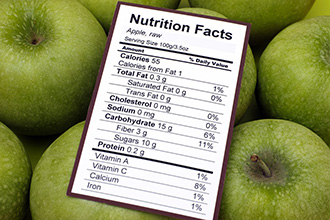A heart failure patient and a diabetic patient walk into a cardiologist’s office looking for advice on following a heart-healthy diet.

This is no joke: They are the same patient. And when someone has cardiovascular problems and another chronic condition, it creates complex health challenges, including special dietary needs.
Nonnie Toth knows those challenges well. As a registered dietitian in the Allegheny Health Network (AHN) Cardiovascular Institute, she spends every day educating patients with heart conditions about how to eat healthfully.
For some patients, that means following a standard heart-healthy diet that’s low in fat, sodium, and cholesterol. Others face dietary “curveballs” because they have additional health conditions.
“When people need to follow ‘multi-diets’, the biggest challenge is making sure they understand all their dietary restrictions,” Toth says. “In the most complex cases, it may be easier to develop the right diet, and help a patient stick to it, by starting with, ‘let’s define what you can eat at this point.’”
As an example of the extra challenges for a ‘multi-diet’ patient, Toth notes that one building block of a heart-healthy diet is fiber — 25 to 35 grams per day. A high-fiber diet rich in fruits, vegetables, and whole grains can help lower cholesterol, which is vital to patients with heart conditions. But if a cardiology patient also has diabetes, the trick is that many high-fiber foods are also high in carbohydrates — which they need to reduce to help control their blood sugar.
“It becomes a balancing act, because we want to get those 25 to 35 grams of fiber per day, but we also need to limit carbohydrates to 45 to 60 grams per meal,” she says.
That’s just one piece in a larger dietary puzzle. For starters, some patients might also need to watch potassium, sodium, and phosphorus.
Toth spends much of her time and energy educating patients at AHN’s outpatient heart clinic, where her main role is advising heart failure and heart transplant patients.
“I want to see every patient when they’re new and also any time they’ve had a hospital stay,” she says. “When patients end up back in the hospital, it can be because they’re not following their diet restrictions. Unfortunately, sometimes it’s only after a hospital trip that someone starts to pick up on just how important the diet is.”
Toth also partners with cardiologists throughout the AHN Cardiovascular Institute to help patients with a range of diagnoses, including high blood pressure, sarcoidosis, cardiomyopathy, and obesity.
While heart patients face unique dietary challenges and risks, Toth says there are valuable lessons for all of us in the adjustments that her patients must make — including, most fundamentally, just paying closer attention to nutrition than they may have in the past.
What exactly makes a diet “heart-healthy?” Setting aside the specific needs that someone may have because of a health problem, Toth explains that “heart-healthy” generally means:

Low in fat, no cholesterol or sodium, 3 grams of fiber — yup, apples pass the label test.
For almost any dietary goals or restrictions, reading nutrition labels (or using other resources to find nutritional information) is crucial. “I hit that lesson hard and read through labels with the patient to make sure they understand,” Toth says. “Telling someone to keep their cholesterol under 200 mg a day isn’t meaningful if they don’t know where to find that information so they can track it.”
Reading nutrition labels empowers you to make good decisions. Consider that goal of keeping cholesterol under 200 mg a day. If you read that the egg you ate this morning had 180 mg of cholesterol, then you know to steer clear of foods with cholesterol for the rest of the day. If you’re trying to eliminate trans fats, then if a label doesn’t say 0, you know it’s not for you.
Almost any dietary change can be challenging at first — but your body will adjust, and your habits will shift, if you stick with the change.
“It takes about 12 weeks for your taste buds to adjust to a lower-sodium or lower-sugar diet,” Toth points out. “But it happens — and after you adjust, when you taste something very salty or sugary, you’ll really pick up on it.”
She emphasizes that there are no quick fixes when it comes to a healthier diet and lasting health benefits. When she has patients who are obese, for example, she says the focus is always on combining a consistent, calorie-controlled diet with exercise — not skipping meals. She also warns against diets that eliminate or severely restrict an entire food group; among other things, she says such diets make it too easy to miss important vitamins and minerals.
Some dietary requirements also involve shifting your definitions or assumptions. For example, Toth points out that patients with both heart failure and high blood pressure must carefully monitor sodium intake, in part because too much sodium may cause water retention, which can raise blood pressure. For the same reason, these patients must often limit their fluids — typically to two liters per day.
“When you’re tracking those two liters per day, you include water, juice, coffee, milk, anything liquid,” Toth explains. “But we also need to include foods that melt at room temperature, like ice cream, jello, yogurt, pudding, ice chips, and popsicles. That’s not necessarily how most people think, so it takes extra effort to remember.”
Toth gives thorough support to her patients. If someone needs to be on a low-sodium diet, she not only reviews high-sodium foods to avoid, she will provide a list of low-sodium alternates to look for in the grocery store. In addition to packets of nutritional information, she frequently provides patients with recipes.
“I spend a lot of time finding quick, easy, affordable recipes that sound good and fit into a heart-healthy, low-sodium diet,” she says. “Then I try them on my own. I take the extra steps, so I can just hand someone a recipe and say, ‘try this.’ It’s like I’m creating a recipe book for people who might not do this research themselves.” (See sidebar for one of her favorite recipes.)
Similarly, she says she’ll often provide tips to help people with the practical side of maintaining their diet. One favorite: If you’re busy, set aside a little time on the weekend to prep some meals and “grab and go” snack food for the week ahead. “I have two crock pots myself, and I use them a lot,” she adds. “Since they make more than I need, I freeze the extra and then I have my own convenient, healthy, ‘frozen meal’ to heat up at a later date.”
For many cardiology patients, someone like Nonnie Toth may actively reach out as part of an overall treatment plan. But Toth emphasizes that you don’t have to wait until you’re being treated for a health condition to consult a dietitian. In particular, she notes that people sometimes get misleading or confusing information from what they see online or on TV. When in doubt, it’s best to consult an expert. (For Highmark health plan members, that’s as easy as contacting Blues On Call at 1-888-258-3428.)
“Nutritionists and dietitians get into this field because they want to help people and they know how much your diet impacts your health,” Toth says. “Nutrition experts shouldn’t be called in only when there’s a complex health challenge — anyone can benefit by getting accurate information on how to eat healthier.”